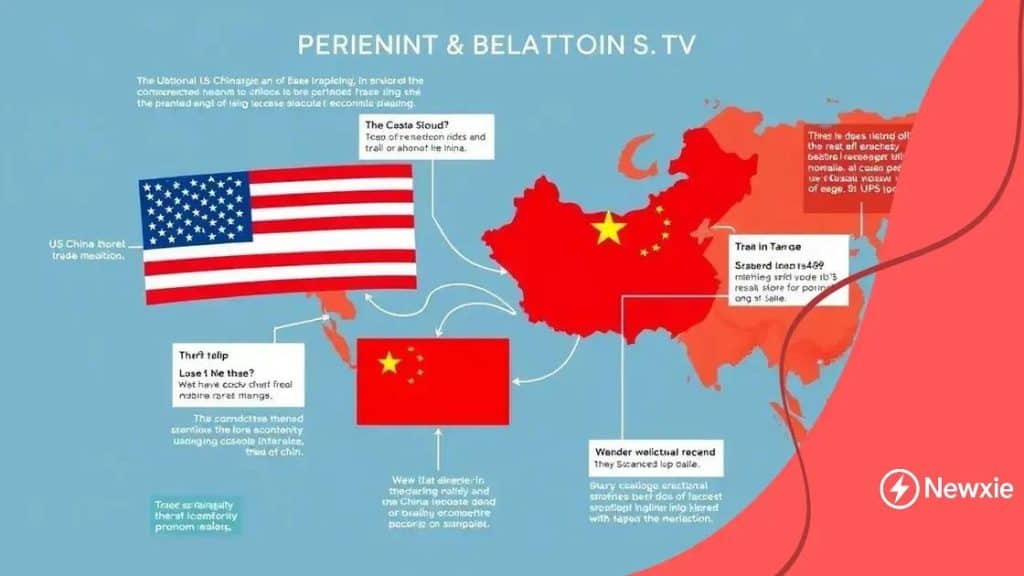US China trade relations: what you need to know

Anúncios
US China trade relations are complex, impacting global markets through tariffs, economic policies, and supply chain dynamics, fostering opportunities for cooperation while presenting significant challenges.
US China trade relations are crucial in understanding today’s global economy. With shifting policies and tariffs, how do these changes impact you? Let’s dive into the details.
Anúncios
Historical context of US China trade relations
The historical context of US China trade relations is essential for understanding the dynamics of their current interactions. For decades, these two nations have engaged in various trade agreements and policies that shaped their relationship.
Early Trade Relations
In the 18th century, trade between the US and China was minimal. However, as the United States expanded, interest in Chinese goods, such as tea and silk, grew. By the mid-1800s, American merchants were eager to access Chinese markets.
Opium Trade and Its Consequences
The opium trade played a significant role in early interactions. The US, along with Britain, became involved in the opium trade, which led to serious conflicts and the eventual signing of unequal treaties. These treaties favored Western powers and often weakened China’s economy.
Anúncios
- Unequal treaties limited Chinese sovereignty.
- Trade imbalances favored foreign nations.
- Increased tensions and conflicts emerged.
As the 20th century approached, trade relations evolved further, with the US establishing diplomatic ties and emphasizing the value of free trade. These interactions were instrumental during both World Wars, as alliances shifted dramatically.
Post-World War II Developments
After World War II, the Cold War era introduced new complexities. The US imposed trade restrictions on China, influenced by ideological differences. However, the need for economic partnerships soon became apparent, leading to a gradual reopening of trade.
Normalization of Relations
The historical turning point came in the 1970s with President Nixon’s visit to China, which opened the door for significant trade agreements. This event marked the beginning of a new chapter in US China trade relations, paving the way for China’s integration into the global economy.
- Introduction of market reforms in China.
- US support for China’s entry into the World Trade Organization.
- Emergence of China as a major trading partner.
Today, understanding the history of these relations helps to contextualize current trade policies and conflicts. The evolving landscape of US China trade relations continues to impact both nations and the world economy.
Current trade policies and tariffs
Understanding the current trade policies and tariffs between the US and China is vital for grasping their trading relationship today. As both nations navigate economic challenges, these policies play a significant role in global commerce.
Recent Tariff Changes
In recent years, tariffs have shifted dramatically, influenced by trade negotiations and political tensions. The US imposed tariffs on a range of Chinese goods, aiming to protect domestic industries. In response, China retaliated with tariffs of its own, creating a complex trade environment.
Impact of Tariffs on Prices
Tariffs directly affect consumer prices. When tariffs increase, the costs for imported goods rise, leading to higher prices for consumers. For example, electronic products, clothing, and various household items saw price hikes, affecting many American households.
- Increased costs for imported goods.
- Impact on consumer purchasing power.
- Challenges for US businesses relying on Chinese imports.
Moreover, these policies have not only impacted US consumers but have also influenced global supply chains. Companies have started looking for alternatives to Chinese suppliers, seeking to mitigate risks associated with tariffs.
Long-term Economic Effects
The long-term effects of these trade policies are still unfolding. Many economists argue that persistent tariffs could slow down economic growth for both nations. As businesses adapt to the new landscape, innovation and competitiveness are key to thriving amid these changes.
While some industries benefit from protectionist policies, others struggle under increased costs. The balance between protecting American jobs and fostering a dynamic economy remains a contentious issue.
- Manufacturing sectors often gain from reduced competition.
- Service industries face challenges in adapting to new costs.
- Potential for long-term economic downturn.
In summary, the intricacies of current trade policies and tariffs are pivotal in shaping the economic futures of both the US and China. As these nations navigate complex challenges, the global market will continue to feel the effects.
Impact on global supply chains

The impact on global supply chains due to US China trade relations is significant. As tariffs and trade policies change, companies worldwide must adapt to new market conditions.
Disruption of Existing Processes
Many businesses relied on seamless supply chains between the US and China. With recent trade tensions, these chains experienced disruptions. Companies faced delays and increased costs, leading to a reevaluation of their sourcing strategies.
Shifts to Alternative Suppliers
To mitigate risks associated with tariffs, many businesses began looking for alternative suppliers outside of China. Countries like Vietnam, India, and Mexico have become popular destinations for manufacturing and sourcing.
- Lower production costs in developing nations.
- Diversification of supply sources to reduce dependency.
- Increased competition among alternative suppliers.
This shift not only changes where goods are produced but also affects logistics and transportation costs. Businesses are now considering the complete supply chain, from raw materials to final delivery, to stay competitive.
Investment in Technology
As companies adjust, many are investing in technology to enhance efficiency and transparency in their supply chains. Using data analytics and automation helps businesses better predict disruptions and respond quickly.
Technology allows for real-time monitoring of inventory and shipments, making it easier to manage supply chains across borders. This innovation may lead to more resilient systems, capable of adapting to sudden changes.
- Adoption of blockchain for secure transactions.
- Use of AI for demand forecasting.
- Improvement of logistics through smart routing.
Ultimately, the impact on global supply chains underlines the importance of flexibility and innovation. As trade dynamics shift, companies must remain agile to thrive in a constantly evolving landscape.
Economic implications for both nations
The economic implications for both nations involved in US China trade relations are profound and multifaceted. As the world’s two largest economies, their trade policies directly impact global markets and local economies.
Economic Growth Rates
Changes in trade relations often lead to shifts in economic growth rates for both the US and China. When tariffs are imposed, consumers may face higher prices, which can slow down spending and overall economic expansion.
Job Creation and Losses
Trade policies also significantly affect job markets. In the US, certain industries may thrive under protective tariffs while others suffer due to increased costs of raw materials. Conversely, China’s economy relies heavily on exports to the US, so disruptions can lead to job losses in manufacturing sectors.
- Increased tariffs may protect US manufacturing jobs.
- Shift in jobs as companies outsource production to other countries.
- Possible job losses in sectors dependent on Chinese imports.
As both economies adjust, they must consider the long-term consequences of their trade decisions. This not only affects employment but also influences wages and living standards across both nations.
Investment Trends
Investment patterns between the US and China are also shifting. Businesses are reevaluating their strategies, leading to changes in foreign direct investment (FDI). For instance, US companies may withdraw investment from China in search of more stable markets.
On the flip side, China may invest in technology and innovation to reduce dependency on US goods and services. This dynamic can shift the balance of global economic power over time.
- Increased investment in technology sectors.
- Diversification of supply chains to reduce risk.
- Emerging markets gaining attention from global investors.
The economic implications of ongoing trade relations will continue to be a significant focus for policymakers in both countries. As each nation navigates the complexities of trade, understanding these implications is crucial for future economic stability.
Future outlook of US China trade relations
The future outlook of US China trade relations is uncertain yet pivotal for the global economy. As these two superpowers navigate their complex relationship, many factors will shape their trading dynamics.
Potential for Cooperation
Despite current tensions, there is potential for cooperation. Both nations benefit from trade and investment. Joint efforts in areas like climate change and technology development can lead to mutual advantages.
Impact of Policy Changes
Future policy changes may also play a critical role. The next US administration could shift its stance towards tariffs and trade agreements. More favorable policies may encourage stronger trade ties and open up new markets.
- Reduction of tariffs could lower consumer prices.
- Increased imports may benefit US consumers and businesses.
- Stronger partnerships in technology and research.
Moreover, China is working to enhance its economic model, focusing more on domestic consumption rather than relying solely on exports. Such a shift could alter import patterns from the US, leading to new opportunities in various sectors.
Challenges Ahead
However, challenges remain significant. Geopolitical tensions, technology competition, and differing economic systems are ongoing hurdles. Decisions made in the coming years will have lasting effects on both economies.
- Regulatory barriers may still hinder trade.
- Cultural and political differences will need to be navigated carefully.
- Dependence on global supply chains may shift as industries adapt.
The future of US China trade relations will likely be characterized by a mix of competition and collaboration. Businesses and consumers must stay informed and agile as these developments unfold.
FAQ – Frequently Asked Questions about US China Trade Relations
What are the main impacts of tariffs on US China trade?
Tariffs can lead to increased prices for consumers and affect the competitiveness of businesses that rely on imported goods.
How do trade policies affect global supply chains?
Changes in trade policies can disrupt existing supply chains, prompting companies to seek alternative suppliers and adjust their sourcing strategies.
What role does technology play in future trade relations?
Technology enhances efficiency and transparency in supply chains, helping businesses adapt to changing trade dynamics.
What opportunities exist for cooperation between the US and China?
There are opportunities for collaboration in areas like climate change, technology development, and economic innovation, benefiting both nations.
SEE MORE CONTENT





